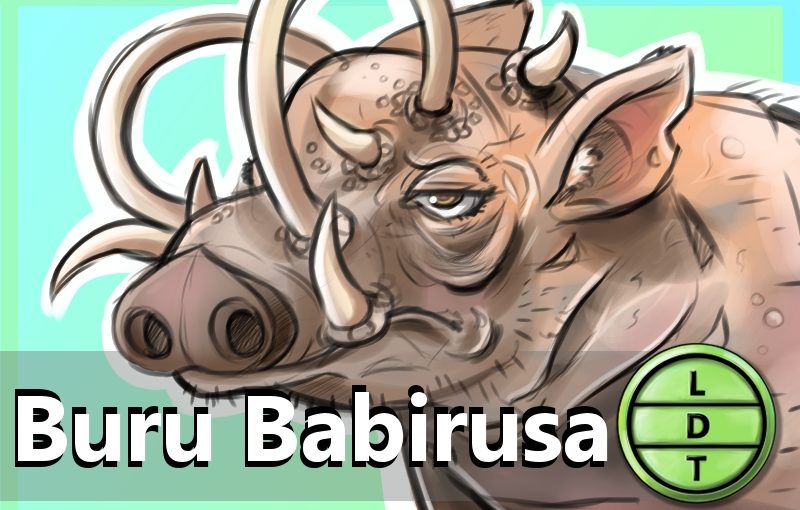“And today we’re talking about a big pig with interesting headgear, but more on that later.”
The jungles of Indonesia have provided several episodes of interesting animal info so far. The terrain seems to provide a smorgasbord of offbeat animals. But none may be as strange as a particular forest pig with an odd dental deviance that leaves all the interested researchers. Some adaptations have a clear purpose, giving an animal an advantage in daily life. However, some abilities or anatomical anomalies seem to only provide a disadvantage to an organism. But mystery is something that any intrepid animal enthusiast must embrace in the exploration of Life, Death, and Taxonomy.
Measure Up
Welcome to the beloved Measure Up segment. The official listener’s favorite part of the show! The part of the show when we present the animal’s size and dimension in relatable terms through a quiz that’s fun for the whole family. It’s also the part of the show that’s introduced by you when you send in audio of yourself saying, singing, or chittering the words measure up into ldtaxonomy at gmail dot com. We don’t have a new intro this week so that means we get to be introduced by an animal and Carlos has to guess what it is.
Body Length
- 85–110 cm (33–43 in)
- 43 inches
- In Sulawesi, there are around 400 granite megaliths that were made by indigneous people starting as far back as 3000 B.C. How many Babirusa go into the largest of these megaliths?
- Hint: The stone structures depict human forms, large pillars, or stone slates. Their purpose is unknown.
- Answer. 4 babirusa. The largest megaliths are 15 feet tall.
Weight
- 100 kg (220 lb)
- Indonesia was once home to the world’s heaviest 10 year old. How many of one go into the other?
- Hint: I said “was once” but don’t worry. He’s okay. In fact, Arya Permana 13 now and over 100 pounds lighter. He eats a diet of fish, vegetables and fruit and enjoys playing football (soccer) and badminton.
- 1.9 babirusa. Arya Permana weighed 30 stone, or 420 pounds.
Major Fact
- Babirusa have lower canines that protrude to form large tusks, similar to those of warthogs.
- However, warthog tusks are formed from the upper jaw and then curl up.
- So what are the babirusa’s upper canines doing?
- When most teeth are forming in the upper jaw, they have dreams of traveling south to bite, chew, and gnaw.
- Not so with the Babirusa’s upper canines.
- They travel up through the jaw and emerge from the top of their snout.
- But they don’t stop there. They grow up and curve back toward the forehead.
- According to recovered skulls, the tusks can grow so far as to impale the head of the animal, possibly killing it.
- So what are these dangerous face ornaments for?
- The answer to that has eluded researchers.
- Typically, tusks and horns are used for a variety of reasons.
- Digging
- Self-defense
- Intraspecific fighting
- Matting display
- Unlike warthogs, female babirusas lack prominent tusks.
- Babirusas also don’t have rostral bones that allow them to dig with their snouts like other pigs.
- Instead they live above ground and prefer shallow roots.
- Prominent mammal expert, and my kind of guy, John MacKinnon submitted a paper in 1981, about the function on babirusa tusks.
- He says, the wear patterns and structure of the tusks suggests that the lower teeth are used offensively while the curved upper teeth are used for defense.
- A video by the Smithsonian channel contradicts that assertion.
- They say that the tusks are brittle and break easily when they are smacked against things.
- They also show footage of two males fighting by going up on their hind legs and boxing with their forelegs, keeping their snouts up to avoid contact.
- The Smithsonian also reports that males with long tusks attract more mates.
- The tusks never stop growing and long lived males usually have the longest tusks.
- Perhaps the fact that some males are able to keep brittle tusks for longer shows their survival prowess.
- Maybe it’s a combination of the two. Perhaps males try to break other’s tusk through competition, and avoid damaging their own tusks.
Hey, LDT listeners. There are so many ways to listen to the show in 2020. You can learn about animals on Spotify, Apple Podcasts, IHeartRadio, and countless other apps and podcathers. However, as far as we can tell the best way we grow is when you share the show with friends and family! After that, reviews really help us grow. So if you don’t mind taking the time, we’d really appreciate a review on itunes or your favorite podcast app. Thanks for listening and engaging!

